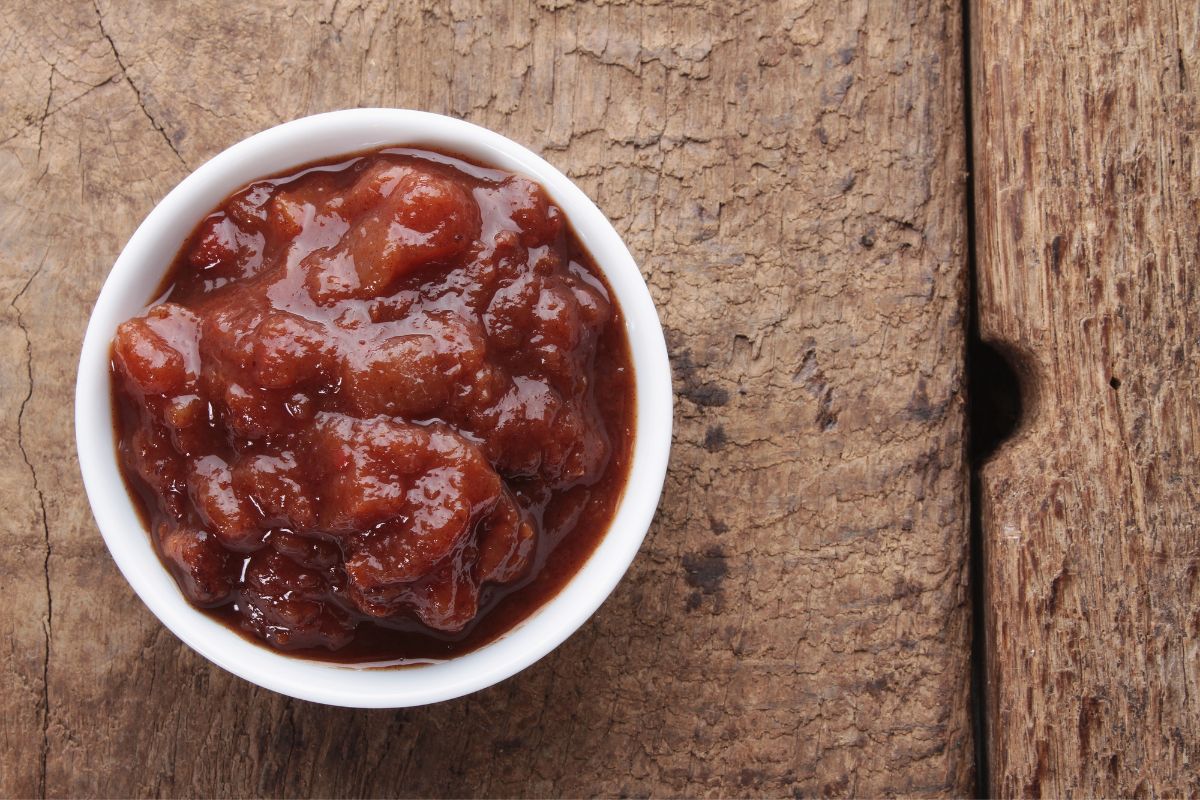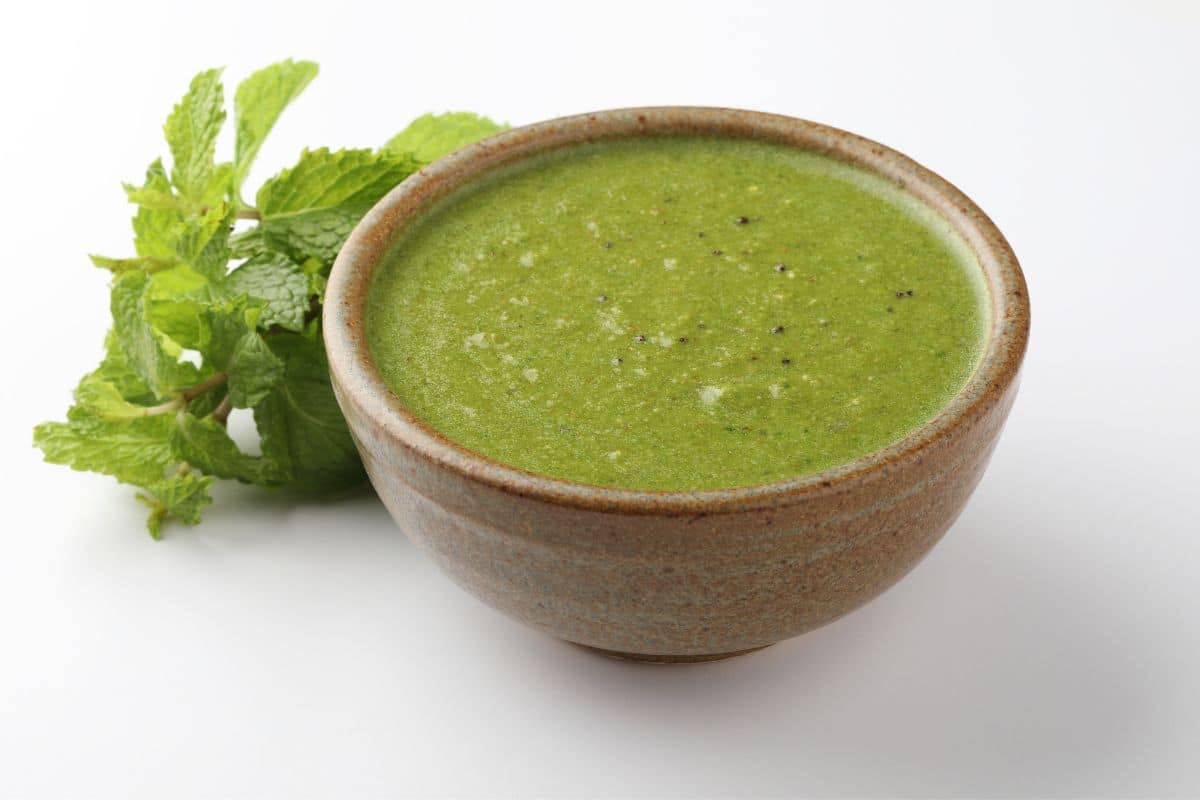Chutney is a super popular condiment that is used in a variety of ways with a variety of different meals. Because chutney is such a versatile thing, it can be difficult to understand exactly what it is and how it should be used in your cooking.

In this guide, we are going to look at what chutney is, what it is made of, the types of chutney that you might come across, and how you can easily make your own chutney at home to save money and avoid food waste.
Keep reading to find out all you need to know about delicious, flavorful chutney.
What Is Chutney?
Before we get into the nitty gritty of what chutney is for and what it can be made out of, it is important to understand just what chutney is.
Chutney is a sauce or condiment that originated in India. Chutneys are often bursting with flavors that have been fermented or concentrated through the process of making the chutney.
The flavor of the sauce is typically produced using spices, fruits, and vegetables.
The process of making chutney involves cooking down a combination of ingredients and spices to create a thick paste.
This helps to magnify the flavors and produce a condiment that complements the accompanying meal perfectly.
Although chutney is most commonly used as a dip or spread alongside other dishes, it can also be used as a marinade to add intense flavor to meats and vegetables. It can also be an interesting addition to soups or stocks.
What Is Chutney Made Of?
As we mentioned above, the basis of chutney usually begins with fruits, vegetables, and spices. However, in order to get the distinctive, and popular tangy flavor that chutney is known for, sugar and vinegar are also added.
Because of the combination of ingredients that are used to make chutney, all kinds of chutney have a stunning sweet and sour taste that is boosted by the addition of sugar and vinegar.
The most common chutneys that you are likely to find in the U.S. include mango chutney, onion chutney, and tomato chutney.
These are all on the sweeter side of chutneys and can often have a little kick to them thanks to the addition of spices.
What Is Chutney Used For?

This is a really good question to ask because the possibilities are vast. The uses of chutneys really depend on the type of chutney that you are using.
For example, mango chutney is often used as a dip for naan bread or poppadoms alongside a curry or other Indian meal.
However, tomato or onion chutney is often used as a spread in sandwiches or as a topping for burgers or hotdogs.
Adding a small amount of chutney to your meal provides an amazing burst of flavor.
If you are using a sweet chutney, such as mango, it can help to cut through the heat and spice of dishes to make them more balanced and palatable.
Chutney can also be used as a marinade for meat. All you need to do is coat your cut of meat with your favorite chutney and let it marinate for a few hours in the refrigerator.
The intense flavors of the chutney will infuse into the meat which helps provide an even and encompassing flavor when it is cooked.
Marinating your meat can also help to tenderize it if necessary and make your meal even more delicious to eat.
Is Chutney Different From Jam And Relish?
It is very common for people to use the terms chutney, jam, and relish interchangeably when they are talking about cooking.
However, these are actually quite different products that all have their own characteristics and uses in the kitchen. Below, we will look at the differences between these condiments.
Chutney
The texture of chutney is particularly chunky and the flavors can be sweet and savory. Sometimes, chutney can be sweet and savory at the same time thanks to the use of vinegar.
Some popular, authentic chutneys are mango chutney, coconut chutney, and tamarind chutney. All of these are perfect for accompanying spicy food to help balance the meal.
Chutney is most commonly used as a condiment to accompany Indian recipes. However, it can also be used as a marinade or glaze for meat protein, as a spread for sandwiches, or as a topping for burgers and hot dogs.
Relish
Relishes are quite similar to chutney, however, there are a few key differences. Relishes are typically made using vegetables that have been finely chopped.
Common vegetables include onions, peppers, and cucumbers. Corn can also be used to make popular relishes. The vegetables are then pickled in vinegar, sugar, and salt.
Relishes often have a tangy and sweet flavor which makes them perfect for topping foods such as hot dogs and burgers.
Despite the similar use of relish and chutney, the texture of relish tends to be smoother and the taste is more tangy than sweet.
Popular types of relish include corn relish, tomato relish, and pickle relish.
Jam/Jelly
The most different condiment from chutney is jelly. This is a spread that is made from cooked fruit, sugar, and pectin.
The texture of jelly is thicker than relish or chutney thanks to the thickening agent that is used when making it.
Jelly should always have a spreadable consistency so that it can be spread on toast and sandwiches. Jelly is normally a very sweet and fruity condiment. It doesn’t feature the same tangy or sour flavor as relish or chutney.
Jelly is most commonly made from sweet fruits such as strawberry, grape, or blueberry.
What Are Different Types Of Chutney?
Now that you know what chutney is, what it is made of, and how it is different from relish and jelly, it is time to look at the different types of chutney.
There are so many different varieties of chutney that you can purchase or make at home. Below is a selection of some of the most popular types of chutney that you can find.
Tomato Chutney
As the name suggests, tomato chutney is a chutney based on tomatoes. This is an incredibly popular chutney in India and is often paired with rice dosa. You can also serve this chutney with savory rice cakes or savory pancakes.
The natural acidity and sweetness of the tomatoes combined with the vinegar and sugar create an incredibly tangy but sweet chutney that goes with almost anything.
Mango Chutney
If you are looking for chutneys from your local grocery store, you are most likely to come across mango chutney on the shelves.
This is because it is incredibly palatable and sweet which is perfect for cutting through the spice of traditional Indian foods.
In the most common form of this chutney, ripe mangoes are combined with lime juice and chili flakes to create a stunningly sweet but sour chutney with a little kick.
It is also possible to find or make mango chutney without the chili if you prefer to keep things tangy rather than spicy.
Mango chutney is most commonly served as a condiment to accompany Indian main dishes such as curries. However, it also goes really well with cheese and grilled meats if you want to change things up a bit.
Coconut Chutney
If you are looking for something to accompany hot curries and take the edge off, coconut chutney is a must. The most common recipe you will find for coconut chutney is for a hotel-style chutney that is often served with breakfast.
Because of the creamy coconut that is used in this chutney, it is often used to cool down the foods that it is served with.
However, there are variations of the recipe that include red chili for spice or cilantro to provide a herby kick.
If you are ordering this chutney at a restaurant, make sure to find out if it is spicy or not to avoid being disappointed.
Garlic Chutney
A slightly more unusual chutney is garlic chutney. This has many different names in India, however, if you are looking for a recipe, searching for garlic chutney is fine. This is a very vibrant but rustic chutney that gives a burst of spicy flavor.
Although we don’t often think of garlic as being spicy, it does have a good hint of spice by itself. In addition to that, garlic chutney is often made with extra chili peppers to boost the heat and flavor.
This chutney makes a great topping to foods such as burgers and sandwiches to give a burst of garlic and chili. It is particularly popular as a topping for Indian street food too.
Tamarind Chutney
If you want to get regional with your chutneys, tamarind chutney is popular in the northern part of India. This is a great chutney for people who want to avoid spice.
The use of tamarind pulp in this chutney combined with the vinegar and sugar makes it tangy, sweet, and sour all at the same time.
This is another chutney that is incredibly popular as an addition to street food such as samosas. It also makes a great dip for bread and crackers or as a topping for grilled meats and sandwiches.
Apple Chutney
When you think of apple chutney, you might find yourself thinking of apple sauce. However, apple chutney is very different with a perfect balance between sweet and sour flavors.
The most common way to make apple chutney includes apples, onions, cinnamon, and ginger. This gives it a very warming flavor without being too spicy.
It makes a great condiment for meat dishes such as roast pork or beef, grilled chicken, and even fish.
Mint Chutney
If you are looking for a chutney that is super versatile to introduce into your kitchen cupboards, mint chutney is for you. This chutney is made with fresh mint and cilantro leaves as well as some warming spices.
This chutney is particularly cooling thanks to the mint and the refreshing cilantro. Because of this cooling effect, it makes a great accompaniment to rich, spicy, or oily curries.
Mint chutney can also make a wonderful salad dressing for those summer evenings when you need something refreshing.
Schezwan Chutney
If you are looking for a chutney that is going to test your tolerance for spice, Schezwan Chutney is for you. This is an indo-chinese fusion chutney that is bursting with flavor and spices.
The main ingredients in this chutney are Kashmiri red chilies, garlic, vinegar, soy sauce, and ginger. The bright red and orange hues of this chutney give away just how spicy it is before you even taste it.
Onion Chutney
Another common chutney that you are likely to find in your local grocery store is onion chutney.
This is a much sweeter chutney than some of the others on this list. It is usually quite a thick chutney with large pieces of caramelized onions.
In some recipes, you might find red chili, curry leaves, and tamarind have been added. This is likely to produce a much tangier chutney than a standard caramelized onion chutney that is more sweet than tangy.
Onion chutney works really well on sandwiches as well as with meat such as sausages.
Curry Leaf Chutney
Traveling to the south of India, curry leaf chutney is a popular condiment. This chutney has a very rich flavor with just a hint of sweetness that makes it perfect for topping rice or dosa.
The curry leaf chutney is made with freshly ground curry leaves, warming spices, and coconut.
This chutney is incredibly easy to make at home, even if you are new to making chutneys. It also stores really well and you can easily adjust the amount of spice that you use.
Peanut Chutney
A type of chutney that you might not have heard of is peanut chutney. This is a thick sauce that is made from curry leaves, lentils, spices, and ground peanuts.
This is a very versatile chutney that can be used with a variety of different Indian dishes and snack foods.
Zucchini Chutney
Zucchini chutney or Zucchini spread is something that you will find in every South Indian home. It will be homemade and quite spicy, all made with a different recipe that will have been passed down through generations.
Zucchini chutney is made from roasted ingredients for an even richer flavor. Urad dal, red chilies, and curry leaves are blended into a paste. Zucchini and tamarind are added to create a fresh flavor that goes with any dish.
How To Make Your Own Chutney
Chutney is a super simple condiment that you can make from scratch at home. It is the perfect way to preserve excess summer vegetables and fruits to avoid them going to waste.
- Prepare a basic chutney by chopping or blending fresh tomatoes, onion, cumin, garlic, chili, cilantro, lime juice, and salt.
- Heat a large skillet over medium heat and add the chopped ingredients together leaving the cilantro and lime juice out. Do not add oil to the pan first as this will affect the texture of the chutney.
- Cook the mixture until the vegetables are soft. This should take around 5 minutes
- Add the cilantro and lime juice. Stir to combine the ingredients.
- Serve the chutney warm, at room temperature, or chilled.
Homemade chutney can be stored for up to six months in an airtight container in the refrigerator.
Tips For Making Chutney
If you are interested in making your own chutney at home, there are a few things you can do to make sure that you get the most out of your ingredients.
- Make sure that you are using the freshest ingredients possible. This will give your chutney the best flavor.
- Use a variety of fruits and vegetables to create rounded and balanced flavors. You can get creative with combinations to find out what works.
- Make sure that the vegetables have been cooked until they are soft before you add other ingredients. This will help to ensure that you have the right texture.
- Allow the chutney to cool completely before you transfer it to an airtight container. This will help to keep the chutney as fresh and flavorful as possible.
- Your chutney can last for up to six months if it is stored correctly. This will allow you to enjoy it as a condiment or as a topping or spread for your meals.
Final Thoughts
There are so many different types of chutney that you can make or try that bring different things to your meals.
If you want to make chutney at home, you can get really creative with your combinations of fruit and vegetables to find new and exciting flavor combinations that really work.
This can be a great way to make sure that you aren’t wasting food that you have bought or grown in the summer.






